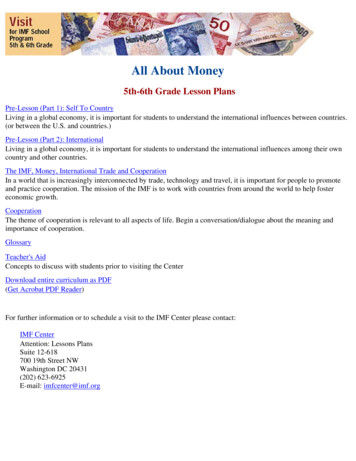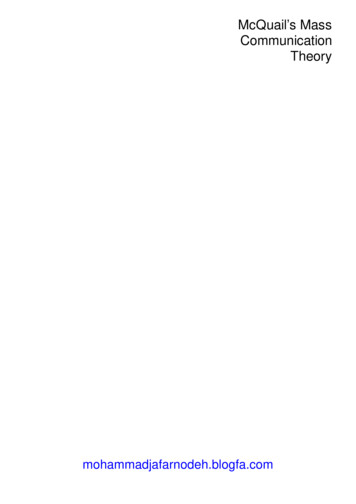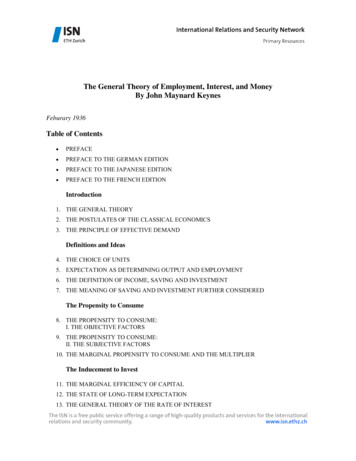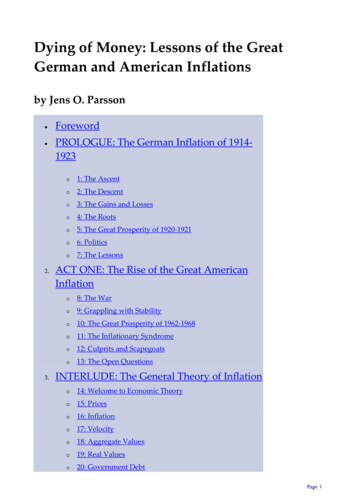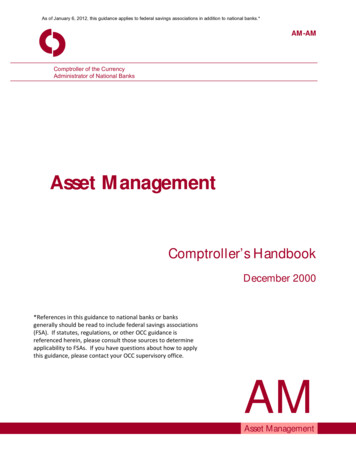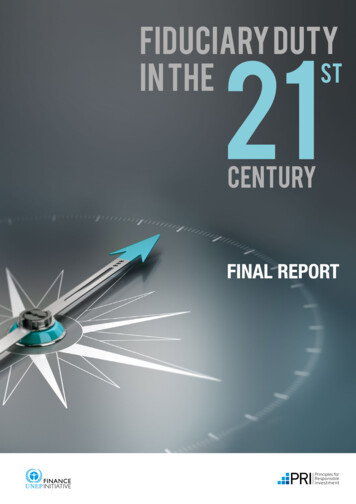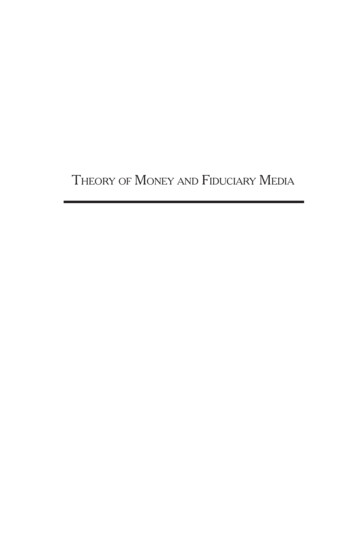
Transcription
THEORY OF MONEY AND FIDUCIARY MEDIA
THEORY OF MONEYandFIDUCIARY MEDIAESSAYS IN CELEBRATION OF THE CENTENNIALEdited byJörg Guido HülsmannMISESINSTITUTEAUBURN, ALABAMA
Copyright 2012 by the Ludwig von Mises Institute. Permission to reprint inwhole or in part is gladly granted, provided full credit is given.Ludwig von Mises Institute518 West Magnolia AvenueAuburn, Alabama 36832mises.orgISBN: 978-1-61016-258-6
CONTENTSIntroduction by Jörg Guido Hülsmann . . . . . . . . . . . . . . . . . . . . . . . . . . . . . . . . . . ix1.The Early Evolution of Mises’s Monetary ThoughtJörg Guido Hülsmann. . . . . . . . . . . . . . . . . . . . . . . . . . . . . . . . . . . . . . 12.Why was the Reception of the First Edition of Mises’sTheory of Money and Credit so Lukewarm?Amadeus Gabriel . . . . . . . . . . . . . . . . . . . . . . . . . . . . . . . . . . . . . . . . 373.Böhm-Bawerk’s Influence on Mises’s Typology of MoneyMalavika Nair . . . . . . . . . . . . . . . . . . . . . . . . . . . . . . . . . . . . . . . . . . . 634.Mises and Value TheoryMateusz Machaj . . . . . . . . . . . . . . . . . . . . . . . . . . . . . . . . . . . . . . . . . 755.Ludwig von Mises as Currency School Free BankerJoseph T. Salerno . . . . . . . . . . . . . . . . . . . . . . . . . . . . . . . . . . . . . . . . . 956.The Influence of the Currency-Banking Dispute onEarly Viennese Monetary TheoryMatthew McCaffrey . . . . . . . . . . . . . . . . . . . . . . . . . . . . . . . . . . . . . . 1277.The Regression Theory as Conjectural HistoryGary North . . . . . . . . . . . . . . . . . . . . . . . . . . . . . . . . . . . . . . . . . . . . 1678.Expansionist Monetary Policies and the Trade BalanceDavid Howden . . . . . . . . . . . . . . . . . . . . . . . . . . . . . . . . . . . . . . . . . 1779.The Subsistence Fund in Ludwig von Mises’s Explanationof the Business CycleEduard Braun. . . . . . . . . . . . . . . . . . . . . . . . . . . . . . . . . . . . . . . . . . . 193v
viTheory of Money and Fiduciary Media: Essays in Celebration of the Centennial10.The Inter-Bank Market in the Perspective ofFractional Reserve BankingNikolay Gertchev. . . . . . . . . . . . . . . . . . . . . . . . . . . . . . . . . . . . . . . . 20911.Modern Business Cycle Theories in Light of ABCTPhilipp Bagus. . . . . . . . . . . . . . . . . . . . . . . . . . . . . . . . . . . . . . . . . . . 22912.The Monetary Theory of Current Textbooks in Light ofThe Theory of Money and CreditRenaud Fillieule . . . . . . . . . . . . . . . . . . . . . . . . . . . . . . . . . . . . . . . . 24713.Mises’s Theory of Money and Credit: Arguments AgainstCentral BankingThorsten Polleit . . . . . . . . . . . . . . . . . . . . . . . . . . . . . . . . . . . . . . . . . 273Index. . . . . . . . . . . . . . . . . . . . . . . . . . . . . . . . . . . . . . . . . . . . . . . . . . . . . . . . . . . 299
IntroductionIn December of 1911, Ludwig von Mises finished revising the proof pagesof his Theorie des Geldes und der Umlaufsmittel. He had worked on thebook for most of the previous six years, and he had also submitted themanuscript to the University of Vienna as a habilitation thesis in order toobtain the much-coveted license to lecture on the university level (venialegendi). A few months later, he would hold the first copies in his hands.At the mere age of 30, he had published a great treatise, the first out of foursuch works that he would publish in his life-time, in addition to a plethoraof smaller books, pamphlets, and articles.1His book was a magnificent synthesis of six strands of literature thathitherto had only been very loosely connected: (1) the classical theory ofmoney, most notably in its Ricardian coloration; (2) the mid-nineteethcentury debate revolving around currency and banking principles; (3) thestandard German textbooks on money and banking, including works byAdolf Wagner, Carl Knies, and Wilhelm Lexis; (4) the works of the Austrian School pertaining to subjective value, prices, capital, and money; and(5) the recent literature on money and banking at the onset of the twentiethcentury, including the writings of Knut Wicksell, Irving Fisher, and Carl1The other three treatises are Socialism (Indianapolis: Liberty Fund, 1981), HumanAction (Auburn, Ala.: Mises Institute, 1998), and Theory and History (Auburn, Ala.: MisesInstitute, 1985). See the complete Mises bibliography at http://mises.org/misesbib.asp. Forgeneral biographical information on Mises see Murray Rothbard, Ludwig von Mises: Scholar, Creator, Hero (Auburn, Ala.: Mises Institute, 1988), Israel Kirzner, Ludwig von Mises: TheMan and His Economics (Wilmington, Del.: ISI Books, 2001), and J.G. Hülsmann, Mises:The Last Knight of Liberalism (Auburn, Ala.: Mises Institute, 2007).vii
viiiTheory of Money and Fiduciary Media: Essays in Celebration of the CentennialHelfferich. Mises also paid due attention to (6) the publications of the mostimportant money cranks (Geldreformer)—authors such as Pierre-JosephProudhon, Silvio Gesell, and Ernest Solvay—who proposed to heal all sortsof economic ills through policies designed to increase aggregate monetaryspending. At the time their ideas had been rejected out of hand by academic economists. Nevertheless they continued to have a significant impact onthe larger public, not least of all because nobody bothered to refute themby following their arguments to their ultimate conclusion.The visible ambition behind the Theorie des Geldes und der Umlaufsmittel was to integrate all the valid elements in the previous literatureinto one coherent and systematic whole, to build this theory up from firstprinciples—that is, from Carl Menger’s theory of value—and to root outthe most important errors about money and banking in the light of thenew synthesis. Mises’s treatise closed a century of monetary thought. Inthe same breath, it opened up new areas for the future development of economic theory, most notably in the fields of economic calculation, businessaccounting, expectations, business cycles, currency competition, monetaryinterventionism, and monetary reform.One of the great misfortunes of the twentieth century was that Mises’sbook was not published some thirty or forty years earlier. Fundamentallynew ideas need at least a generation or two to become the majority opinion among the experts, and thus to have any practical impact. The Wealthof Nations (1776) had such an impact only as from the 1840s, after manyyears of vociferous and strong support from outstanding economists suchas David Ricardo, James Mill, and Jean-Baptiste Say. Mises did not havesuch support. The wrong ideas that he had very effectively refuted—mostnotably, the ideas of the Banking School—enjoyed the support of JohnStuart Mill and other respected economists. They had already begun towork their way through the minds of academia and politics. By the timeMises published his treatise, this ill-fated movement was in full swing andhad conquered the hearts and minds of the new generation. John MaynardKeynes read and even appreciated Mises’s book, but all in all he considered it to be old-fashioned. However, he later confessed that his Germanlanguage skills were superficial.2 Irving Fisher had worked for many years2Keynes had written a book review of Mises’s treatise, stating it “is the work ofan acute and cultivated mind. But it is critical rather than constructive, dialectical and notoriginal. The author avoids all the usual pitfalls, but he avoids them by pointing them outand turning back rather than by surmounting them.” (Economic Journal, September 1914,
Introductionixon turning economics into a quantitative discipline, and many others hadjoined their forces. They would not be deterred because of some difficultieson the level of basic theory, such as the ones Mises had highlighted in histreatise.As a consequence, for many years, the Theorie des Geldes und der Umlaufsmittel has been read, studied, criticized, and developed mainly by Mises’s own students. F.A. Hayek and Fritz Machlup in the interwar period,and Hans Sennholz, Murray Rothbard, and George Reisman after WWIIwere first in line. They preserved the Misesian approach throughout thedark ages of socialism and rampant interventionism.But even the most ardent love for their teacher could not have keptthe flame alive. The growth of attention to Mises’s monetary treatise—slowfor many years, almost explosive within the past two decades—has beenspurred by two other forces.The first one is the power of truth. Mises’s book is not just a very solidpiece of scholarship, both in its factual foundation and in its argument. Itis also original, written with a philosophical bent and with an astoundingknowledge of the history of money and banking. Its judgements are amazingly mature for an author of barely thirty years of age. These qualities giveit unequalled depth, width, and balance. They have attracted readers allthroughout the past century, and even in its darkest hours. The book hasbeen in print almost without interruption and was translated into six languages. Of particular interest is the English translation by Harold E. Batson,first published in 1934 in London by Jonathan Cape and republished in allsubsequent American editions.3 The book was also translated into Spanish,4p. 417). Sixteen years later he stated that “in German, I can only clearly understand whatI know already!—so that new ideas are apt to be veiled from me by the difficulties of language.” Keynes, A Treatise on Money (London: Macmillan, 1930), vol. I, p. 199, note 2.3The 1953 edition (New Haven, Conn.: Yale University Press) included an additional fourth part on “monetary reconstruction” that Mises had written for this new edition.In that form the book was published again three more times: 1971 (Irvington-on-Hudson,N.Y.: Foundation for Economic Education; second print in 1978), 1981 (Indianapolis: Liberty Fund), and 2009 (Auburn, Ala.: Mises Institute).4Several Spanish translations (La Teoría del Dinero y Del Crédito) have been made:one by Antonio Riaño, published in 1936 (Madrid: M. Aguilar), one by José Ma. Claramunda Bes (Barcelona: Ediciones Zeus, 1961), and one by Juan Marcos (Madrid: UnionEditorial, 1997).
xTheory of Money and Fiduciary Media: Essays in Celebration of the CentennialJapanese,5 Chinese,6 Russian,7 and French.8 Even the second German edition of 1924 (without the fourth part of the American editions) has recently been reprinted by the original publisher (Berlin: Duncker & Humblot,2005).The second force sustaining interest in Mises’s book is, ironically, thealmost complete neglect of its content in mainstream thought. In the postWWII era, academic monetary economists have turned themselves intohandmaidens of central banks and other monetary authorities. In theirquest to be “practical” and “relevant” they have neglected to study, and toquestion, the theoretical foundations of the “conventional” approach thatthey had inherited from the Banking School. As a consequence, they haveeventually adopted a great number of the inflationist ideas of the nineteenth century. Some of those who a century ago would have been considered to be cranks are today respected academic experts on money andbanking.Unsurprisingly, we have trodden down the expansionary-monetarypolicy-road all the way to its logical dead end. One hundred years of monetary experiments and manipulations have not ushered into a brave newworld of growth, stability, and liberty. Rather, in all countries they haveproduced rampant cronyism, uncontrolled growth of the state, economicand political dependence of the great mass of the population, comparatively sluggish growth even in the midst of enormous technological progress,and never-ending sequences of booms and busts.This sorry state of affairs invariably raises questions about the state ofeconomic knowledge. Those who ask such questions are likely to end upreading Mises. Whoever is earnest enough to enquire into the shortcomings of contemporary mainstream economics, and to look for alternatives,5The Japanese translation was made from the second German edition by YoneoAzuma: Kahei oyobi Ryütüjshudan no Riron (Tokyo: Jitsugyo no Nipponsha, 1949) and republished in 1980 (Tokyo: Nihon Hyöron-Sha).61969).Translated by H.P. Yang (Taiwan: Taiwan Bank, Economic Research Department,7The Russian translation, along with annotations, was made by G. Sapov who usedboth the American edition and the second German edition: Теория денег и кредита (Chelyabinsk: Sotsium, 2012).8The French edition (La Théorie de la monnaie et du crédit) is incomplete andonly available on the Internet (http://herve.dequengo.free.fr/Mises/Tmc/TMC 1 1.htm).A print edition is forthcoming along with a preface from Antoine Gentier (Paris: Editionsde l’Institut Charles Coquelin).
Introductionxiis likely to encounter the Theorie des Geldes und der Umlaufsmittel or someof the works it has inspired.In a word, Mises’s book is a classic, but it is more than a classic. It is ofcurrent interest, and will remain so, as long as the majority of the economistsrely in their monetary thought precisely on those wrong foundations thatMises demolished once and for all in 1912. Its current interest will actuallygrow if professors of economics think they can go on writing, teaching,and counselling without doing their homework. It will grow unless theystart reading Mises, and the literature he quotes, and the literature he hasinspired.Unfortunately, such a change of heart is nowhere near in sight. At thevery moment of this writing, two eminent academic economists in theUnited States have gone to some length trying to discredit Mises’s monetary thought—which they believe to be the intellectual backbone of a political campaign that they despise—yet without making the slightest effortto acquaint themselves with the views they are attacking. One of them evensurmises that Mises’s opposition to fraction-reserve banking “springs outof Medieval Christian (and earlier) condemnations of usury as unjust enrichment.” He then goes on to speculate on “where von Mises is comingfrom,” again, without taking the time to actually read and study any ofMises’s writings, except for short paragraphs quoted seemingly at random.Unsurprisingly, he ends up imputing all kinds of views to Mises that thelatter did not endorse at all, for example, the view that fractional-reservebankers are inherently fraudulent: “These people, Ludwig von Mises says,are thieves: thieves pure and simple.” Or, another half-baked characterization, this time of Mises’s business-cycle theory: “And, Ludwig von Miseswould say, the larger the unbacked circulating medium the bigger the lieand the theft. It is all guaranteed to end in tears. Whenever society thinksthat it is richer than it is, plans will be inconsistent and unattainable. Whenthat unattainability becomes manifest, that will trigger the crash and thedepression. That is, I think, where von Mises is coming from.”9Admittedly, these statements were made in a journalistic publication.But even so they do betray a sorry lack of erudition and integrity. It can9Brad Delong, “Paul Krugman Asks a Question: On the ‘Austrian’ Hatred ofFractional Reserve Banking, Paper Money, etc. Weblogging” l#more; accessed on 3 October 2012, at 9h32CET)
xiiTheory of Money and Fiduciary Media: Essays in Celebration of the Centennialonly be hoped that the rising generation of academic economists will notfollow this example.Fortunately, Mises’s monetary thought is being carefully studied bya growing number of scholars—many at the beginning of their career—from all over the world. The following pages feature thirteen essays written in celebration of the centennial of the first publication of the Theoriedes Geldes und der Umlaufsmittel. Accordingly, the title of the present volume—Theory of Money and Fiduciary Media—is the literal translation ofthat original German title, which unfortunately had not been used for theEnglish edition of 1934, and for all subsequent American editions.10Most of the following papers (chapters 1, 2, 5, 6, 7, 9, 12, and 13) werepresented at a symposium within the Austrian Scholars Conference in Auburn, Alabama on March 8-10, 2012. Chapters 4 and 11 were prepared forthat symposium, but could not eventually be presented there for technicalreasons. And chapters 3, 8, and 10 were solicited from their authors afterthe symposium as a complement for the present volume.Our opening chapter outlines the logical structure of Mises’s book andhighlights the evolution of his monetary thought, with special emphasison the changes between the two German editions of his treatise, and on itsEnglish translation. One main finding is that Mises’s arguments initiallyrevolved around the so-called inner exchange value of money, whereas inlater works he criticized the pertinence of that perspective and focusedmore on the question of how money is being produced (competitively ormonopolistically).In the second chapter, Amadeus Gabriel studies the continuities anddifferences between Mises’s treatise and the standard German-languagetextbooks on money and banking in the late nineteenth and early twentieth century. He highlights several intriguing facts, most notably, that theseforerunners were well acquainted with the existence and relevance of Cantillon effects, and with the idea that the use-value of money was a function of its previous purchasing power. However, they did not endorse themonetary axiom of Hume, Ricardo, and the Currency School according towhich the size of the money stock was essentially unrelated to the production of wealth.Malavika Nair stresses the importance of Mises’s subjectivist typologyof money for current historical research and she traces the basic distinction10On the shortcomings of the Batson translation, see chap. 1, below.
Introductionxiiibetween money and money substitutes back to Eugen von Böhm-Bawerk’seconomic analysis of legal rights and legal obligations (chapter 3). She pointsout that Böhm-Bawerk had elaborated his own theory starting from a critical discussion of the monetary theories of John Law and Henry D. Macleod.In the subsequent chapter 4, Mateusz Machaj revisits one of Mises’sneglected achievements in the Theorie des Geldes und der Umlaufsmittel,namely, the transformation of Carl Menger’s theory of value. Mises basedthe theory of subjective value squarely on the phenomenon of choice. Athis hands it became so-to-say a decisional theory of value. Machaj compares this approach to the present-day neoclassical approach. He stressesthe fact that, in the Misesian framework, subjective value is context-dependent, whereas in the neoclassical framework it is an ultimate given. Hehighlights the implications for the debate on economic calculation in socialist economies.Joseph T. Salerno revisits the on-going debate on free banking and examines the question whether Mises’s monetary thought stands in the tradition of the Currency School (chapter 5). He emphatically answers thisquestion affirmatively. However, he underscores that Mises, at least in themore mature exposition of his theory of money in Human Action, did notendorse the typical policy stance of the Currency School. Rather, he became a champion of free banking precisely because he expected free banking to limit the money supply much more effectively than any governmentintervention.In chapter 6, Matthew McCaffrey sets forth an in-depth study of threeyoung Viennese authors who in the early twentieth century became famous for their treatises on money and banking: Schumpeter, Hilferding,and Mises. Most notably he examines the question to which extent thesewriters worked in the continuity of the nineteenth century debate betweenthe Currency School and the Banking School. He finds that Mises was essentially a representative of the Currency School, Hilferding a championof the Banking School, whereas Schumpeter occupied some intermediateposition. Intriguingly, all three authors tried to complement the earlier theories by focusing on the dynamic transformation of the economy resultingfrom changes in monetary conditions.Switching from the history of thought to philosophy, Gary Northtakes issue with the epistemological status of one of Mises’s most famousmonetary theorems, namely, the regression theorem (chapter 7). He argues that this theorem cannot be deduced from the logical structure of human action. It is not part of praxeology. Rather, it is more akin to some sort
xivOn the Theory of Money and Fiduciary Media: Essays on the Centennialof conjectural history, or to “developmentalism” as understood by RobertNisbet.The next paper (chapter 8) stresses the relevance of Mises’s theory ofinternational monetary relations for the present-day debate on international competitiveness. David Howden argues that Mises anticipated mostof the later literature in focusing his analysis on individual prices, expectations, and exchange rates. Mises’s argument that expansionary monetarypolicy was not likely to increase a country’s competitiveness was reinforcedthrough later refinements of his business cycle theory. Still, Howden statesthat Mises never got to integrating these two elements cohesively and completely.The next three chapters revolve around one of the most importantachievements of Mises’s treatise, namely, his theory of economic crises. Inchapter 9, Eduard Braun argues that the presentation of this theory in Human Action (1949) does not rely on the core concept of the subsistencefund, used by previous authors such as the classical economists and alsoby Böhm-Bawerk. As a consequence, the explanation of the turning pointof the business cycle becomes unconvincing. The original exposition of thetheory in the Theorie des Geldes und der Umlaufsmittel did not suffer fromthis shortcoming and must therefore be considered to be superior to hislater work, at least in that regard. It was also the starting point for refinements of Mises’s theory by F.A. Hayek and Richard von Strigl.Nikolay Gertchev extends Mises’s theory of banking by consideringthe impact of the inter-bank market on fractional-reserve banking (chapter 10). He argues that inter-bank loans are foundational for the latter, thatis, fractional-reserve banking could not get off the ground without relyingon an inter-bank loan market. Moreover, Gertchev points out that the veryexistence of an inter-bank market tends to destroy any limitations on theoverall issue of fiduciary media within a fractional-reserve banking system. Despite Mises’s and Rothbard’s contentions to the contrary, free banking would therefore not be a suitable institutional arrangement to limit theexpansion of the money supply.In chapter 11, Philipp Bagus compares Mises’s business cycle theorywith the prevailing conceptions of booms and busts in our day. He considers Friedman’s plucking model, equilibrium business cycle theory, realbusiness cycle theory, new Keynesian business cycle theory, and Minsky’sfinancial instability hypothesis. Bagus comes to the stern conclusion thatwhat is valid in the present-day theories has been stated more pertinently inMises’s framework, whereas the genuinely new elements in contemporary
Introductionxvbusiness-cycle theory are unacceptable, lacking as they are in coherenceand realism. According to Bagus, this explains the current popularity ofthe Austrian approach among market analysts.The next paper sets out for a similar comparison, but from a more fundamental point of view. Examining present-day textbooks on money, Renaud Fillieule raises the question whether and to which extent these workscome to grips with a number of basic insights that can be found in Mises’sone-hundred-year-old treatise (chapter 12). He focuses on the functions ofmoney, the typology of money, the determination of the purchasing powerof money, the demand for money, and the neutrality of money. Fillieulecomes to the startling conclusion that there is an inverse relationship between the sophistication of a present-day text and its pertinence on thoseissues. The more “advanced” texts tend to be more deficient than the moreelementary ones.In the final chapter of the present volume (chapter 13), Thorsten Polleitreviews Mises’s arguments against central banking, as exposed in his monetary treatise, and compares them with present-day mainstream theoretical arguments in favor of central banking, both on economic and ethicalgrounds. He focuses in particular on price-level stabilization policies, onthe destabilizing effects of central banking, and on the regression theorem.Polleit concludes that on each account, Mises’s case is stronger than thecase for central banking.Current research in Austrian economics is still very much indebted to,and inspired by, Ludwig von Mises’s foundational works, most notably histheory of money and fiduciary media. Looking back at this masterful treatise, reviewing it with a critical eye, informed by the experience of the pastcentury, is like a journey back to one’s roots. It is patent that these roots stillnourish, and will continue to feed, the theory of money and banking in thetwenty-first century. It is therefore our hope that the works contained inthe present book will provide useful starting points for future research andthe further growth of the Austrian School.Jörg Guido HülsmannAngers, 10 October 2012
1JÖRG GUIDO HÜLSMANNThe Early Evolution of Mises’sMonetary TheoryThe publication of Ludwig von Mises’s Theorie des Geldes und der Umlaufsmittel in 1912 marks a turning point in the history of economics, andof the Austrian School in particular. Mises integrated the theory of moneywithin the framework of the theory of subjective value pioneered by CarlMenger. Based on this foundation he revisited all the great monetary debates of his time and of the preceding century, and weighed in these debateswith original and penetrating arguments, each of which he articulated at itsproper place within the edifice of an encompassing monetary treatise.He also made an astounding number of other major contributions,so-to-say in passing. Most notably he developed the general theory ofsubjective value itself by stressing that value was rooted in choice. Hedeveloped a subjectivist typology of money starting from which he delivered a systematic theory of the causes and consequences of moneyprices. He applied that theory to international relations, thus becominga pioneer of international monetary economics. He analyzed the pricing process in unorganized markets. He delivered in-depth refutations ofthe mechanical quantity theory of money, of mechanical price theories,Jörg Guido Hülsmann is professor of economics at the University of Angers in France.1
2Theory of Money and Fiduciary Media: Essays in Celebration of the Centennialof the index-number method, of Currency School theory, and of Banking School theory. Last but not least, he developed a theory of economiccrises, stressing that monetary expansion is likely to entail inter-temporaldisequilibria of the structure of production. Side by side with these major contributions, Mises fleshed out various other noteworthy themes. Forexample, he highlighted particular features of economics as compared toneighboring disciplines such as law or history; and he made several important observations on monopoly theory, on economic calculation, and onthe consequences and limitations of government interventionism.Mises’s monetary thought would remain the backbone of his entireeconomic theory. Eventually he would articulate it within the larger context of a general theory of human action, but the main theses remainedunaltered.1 The first publication of his treatise in 1912 presented morethan a full-fledged theory of money prices. It opened virtually all othermajor threads of his later work as well, with the notable exception of epistemology.2 While Mises changed his mind on a certain number of issues(see Gertchev 2004) his theory of money features a remarkable continuitythroughout the four decades stretching from the first to the last edition ofhis treatise.3 The purpose of the following pages is to highlight the logicalstructure of his treatise and its chief contributions, as well as the most notable changes made to the second German edition of 1924 and the Englishedition of 1934.41“Writing my Nationalökonomie afforded me the opportunity to think throughmy theory of money and credit yet again and present it in a new form. . . . Thus did I carryout the plan I had conceived thirty-five years earlier; I combined the theory of indirectexchange with the theory of direct exchange into a unified system of human action.” Mises(2009, pp. 94f.)2However, the most important facts which eventually would become the startingpoints for his methodological and epistemological reflections were already highlighted inthe Theorie des Geldes und der Umlaufsmittel in 1912. See below, pp. 4f.3To our knowledge, no scholar has so far traced the evolution of Mises’s economicthought back to the first edition, which was never translated into English. This also concerns most notably Pallas (2005) and Hülsmann (2007).4All references to page numbers of the first edition of 1912 are preceded by the letter “A”. Similarly, references to page numbers of the second edition of 1924 are preceded bythe letter “B” and the letter “C” refers to the widely used American edition of 1981, which isidentical with the English edition of 1934, except for the spelling and the additional fourthpart added to the 1953 American edition.
The Early Evolution of Mises’s Monetary Thought3THE LOGICAL STRUCTURE OF HIS TREATISEIn Theorie des Geldes und der Umlaufsmittel, Mises extended and developed Carl Menger’s (1871, 1892) general approach to economic analysisand the theory of money in particular. Menger had shown that the marketpri
new synthesis. Mises's treatise closed a century of monetary thought. In the same breath, it opened up new areas for the future development of eco-nomic theory, most notably in the fi elds of economic calculation, business accounting, expectations, business cycles, currency competition, monetary interventionism, and monetary reform.

